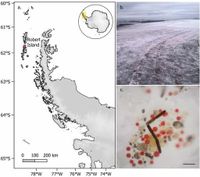The impact of algal blooms on the Robert Island ice cap is substantial, enhancing ice melt and revealing unexpected biodiversity.
In a groundbreaking study examining the Robert Island ice cap in Antarctica, researchers have reported the extensive presence of algal blooms that cover nearly 20% of the ice cap, contributing to significant alterations in melting processes and revealing a wealth of previously understudied biodiversity. Conducted by a team of scientists, the research highlights how these brightly colored algal blooms may play a crucial role in the Antarctic cryosphere and the broader implications of climate change.
Among the most astounding findings is that algal blooms were found to cover up to 2.7 km² of the measured area of the Robert Island ice cap, with cell densities soaring as high as 1.4 x 106 cells ml−1. This discovery is part of a trend showing how biological systems are increasingly interacting with glacial environments, with blooms significantly affecting the surface melting dynamics, contributing around 2.4% of the total melt when observed in situ. Algal species typically included could be identified as belonging to groups such as Chlorophyceae, Trebouxiophyceae, and Ancylonema, indicating a rich and diverse microbial life thriving on the ice.
The study, published on March 18, 2025, builds on the urgency of understanding how warming temperatures and changing climate patterns reshape Antarctic ecosystems. Temperatures have steadily risen in recent decades, leading to substantial alterations in weather and melting patterns across the region. The South Shetland Islands, where the Robert Island ice cap is located, are notable for their thick ice coverage that can extend across nearly 88% of their landmass. As per predictions, ongoing climate change could lead to the significant loss of snow and ice cover across this region, signaling a potential tipping point for global sea levels.
A significant part of the research involved the use of remote sensing techniques in conjunction with field sampling to quantify the extent of the algal blooms observed on the ice cap. The researchers employed a range of methods to ensure accurate measurements of algal communities, including cell density assessments and spectral analysis of blooming surface areas. Their findings indicate that blooms were present from January 7 to February 24, 2023, demonstrating their seasonal patterns of growth.
The blooms’ contributions to the biological albedo reduction (BAR) processes represent a notable concern; as darker algal formations emerge on the ice surface, they increase the local melting rate by absorbing more solar radiation—thereby leading to a further decline in snow and ice cover. This feedback mechanism has been reported to speed up processes affecting both regional and global climates.
One of the study's authors noted, “The density and scale of algal blooms on the Robert Island ice cap point to the significance of these communities as a major photoautotrophic system in the maritime Antarctic.” This highlights a turning point in understanding how even the seemingly remote and inhospitable ice landscapes are home to vibrant life forms that significantly influence ecological dynamics.
In addition to the extent of the blooms, the researchers documented a wide range of cell morphologies within the algal communities, particularly within the Ancylonema genus. The observed genetic diversity adds a layer of complexity to the already rich tapestry of life surviving on the ice, providing insights into the emergent adaptability of these communities in harsh conditions.
Remote sensing imagery captured the extent of the algal bloom, revealing their rapid spread across various ice cap surfaces. The research indicates the blooms' potential for increasing ice melt rates—averaging at estimates of around 0.5 cm per day, which translates into a significant volume of meltwater derived solely from algal presence.
The findings prompt a call for further research into the ecological roles of algal blooms in larger glacial systems and their implications for climate modeling. Understanding these biological contributions could hold the key to learning about the durability of ice ecosystems under future climate scenarios. Acknowledging their potential ecological and atmospheric impacts, the researchers recommend enhanced monitoring and ground-truthing of algal communities across Antarctic ice caps and glaciers.
The study ultimately positions itself within a larger framework of understanding how the intertwined fates of biological systems and climate processes affect not only the Antarctic regions but the planet as a whole, emphasizing the urgency of ongoing investigations into these remarkable ecosystems. Addressing the complexity of these dynamics requires comprehensive studies that balance ecological assessment and climate impact analysis.
In conclusion, the work on algal blooms at the Robert Island ice cap illustrates an essential shift in understanding Antarctic ecosystems, highlighting potential biological contributions to glacial melt rates and alarmingly revealing the intricate link between climate change and biodiversity in one of the Earth's last frontiers.

